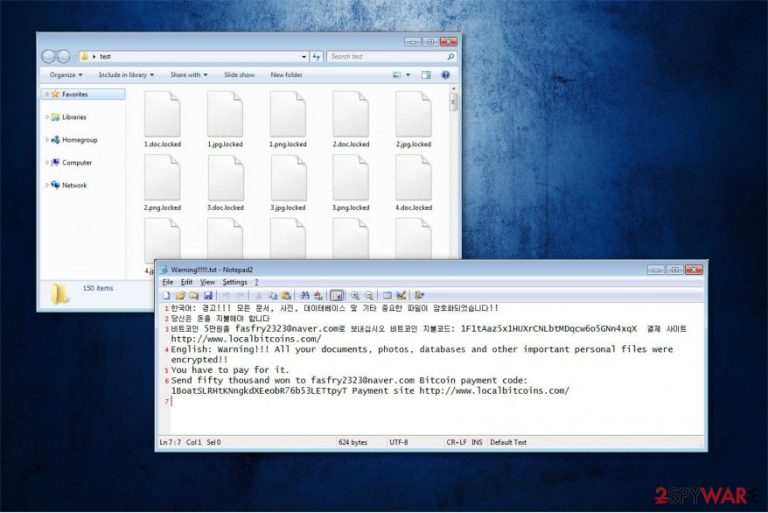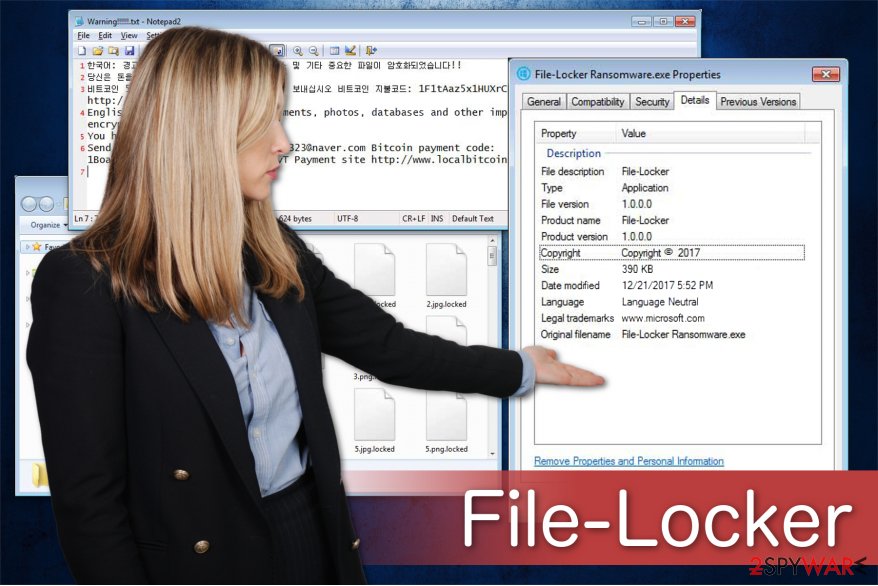File-Locker ransomware (Removal Guide) - Jan 2018 update
File-Locker virus Removal Guide
What is File-Locker ransomware?
File-Locker ransomware demands 50 000 Won from Korean victims

File-Locker is a ransomware-type virus which is categorized as a new variant of the infamous HiddenTear. It uses AES ciphers to encrypt the most widely used data and appends .locked or .razy extension afterward[1]. However, according to the latest researches, it has nothing in common with Razy ransomware.
According to the IT specialists, it reaches the system as File-Locker Ransomware.exe file which is the executable of the file-encrypting virus. Once the malware is inside, it starts corrupting data and drops Warning!!!!!!.txt file to inform a computer user about the attack. Currently, it mainly targets people from Korea since it demands to pay 50K Won as a ransom.
File-Locker ransom note is written in both, Korean and English, languages. The latter version states the following:
English: Warning!!! All your documents, photos, databases and other important personal files were
encrypted!!You have to pay for it.
Send fifty thousand won to fasfry2323@naver.com Bitcoin payment code:
1BoatSLRHtKNngkdXEeobR76b53LETtpyT Payment site: http://www.localbitcoins.com/

You can easily remove File-Locker with the help of the powerful security software. This automatic elimination procedure only requires you to download the antivirus software and let it scan your system thoroughly. If you want more detailed guidelines, head straight to the instructions below.
Note that File-Locker removal is a challenging process and you should not try to get rid of the malicious program yourself. Ransomware-type viruses are able to infiltrate other high-risk computer infections, and you might end up only harming your computer even more.
The most widely used ransomware distribution techniques
While it is currently not enough information to state which distribution method ransomware developers have employed, BedyNet.ru[2] experts believe that they have combined several ones to increase the rate of infections:
- Malicious email attachments;
- Obfuscate application files on P2P networks;
- Fake software updates.
Ransomware can reach the targeted systems as a spam emails holding the executable file. Usually, crooks try to convince gullible people to open the malicious attachment by imitating well-known companies. People are informed about the specific problem and urged to check the attachment for further details.
Unfortunately, once it is opened, the ransomware infiltrates on the system and starts data encryption. Furthermore, obfuscate software files might be placed on peer-to-peer networks which might look extremely genuine[3]. Therefore, the users are advised to closely monitor their online activity and avoid any illegal downloads which may put their security at risk.
Note that a vast of people get tricked to manually install malware once the fake pop-up window or ad appears threatening their privacy. However, be aware that it is merely an attempt to intimidate you and infect your computer by making unthoughtful decisions.
Learn the best way to get rid of File-Locker virus
Once again, we kindly ask you to get help from the professionals in case of File-Locker virus attack. This is a highly dangerous program which might trick you to delete legitimate Windows processes once you try to get rid of it. Also, it may let other computer threats in without your knowledge.
Therefore, we do not recommend trying to remove File-Locker Razy ransomware alone for a regular computer user. Instead, we suggest you two options — either install a powerful security software now or follow the instructions below. Both of these methods will help you to eliminate this computer hazard safely.
If you decide to perform automatic File-Locker removal we suggest using FortectIntego, SpyHunter 5Combo Cleaner, or Malwarebytes. These antivirus tools are tested by our security experts and highly advised to use in case of ransomware.
Getting rid of File-Locker virus. Follow these steps
Manual removal using Safe Mode
To remove File-Locker ransomware you must first disable the virus. Follow the steps given below and boot your computer into Safe Mode with Networking.
Important! →
Manual removal guide might be too complicated for regular computer users. It requires advanced IT knowledge to be performed correctly (if vital system files are removed or damaged, it might result in full Windows compromise), and it also might take hours to complete. Therefore, we highly advise using the automatic method provided above instead.
Step 1. Access Safe Mode with Networking
Manual malware removal should be best performed in the Safe Mode environment.
Windows 7 / Vista / XP
- Click Start > Shutdown > Restart > OK.
- When your computer becomes active, start pressing F8 button (if that does not work, try F2, F12, Del, etc. – it all depends on your motherboard model) multiple times until you see the Advanced Boot Options window.
- Select Safe Mode with Networking from the list.

Windows 10 / Windows 8
- Right-click on Start button and select Settings.

- Scroll down to pick Update & Security.

- On the left side of the window, pick Recovery.
- Now scroll down to find Advanced Startup section.
- Click Restart now.

- Select Troubleshoot.

- Go to Advanced options.

- Select Startup Settings.

- Press Restart.
- Now press 5 or click 5) Enable Safe Mode with Networking.

Step 2. Shut down suspicious processes
Windows Task Manager is a useful tool that shows all the processes running in the background. If malware is running a process, you need to shut it down:
- Press Ctrl + Shift + Esc on your keyboard to open Windows Task Manager.
- Click on More details.

- Scroll down to Background processes section, and look for anything suspicious.
- Right-click and select Open file location.

- Go back to the process, right-click and pick End Task.

- Delete the contents of the malicious folder.
Step 3. Check program Startup
- Press Ctrl + Shift + Esc on your keyboard to open Windows Task Manager.
- Go to Startup tab.
- Right-click on the suspicious program and pick Disable.

Step 4. Delete virus files
Malware-related files can be found in various places within your computer. Here are instructions that could help you find them:
- Type in Disk Cleanup in Windows search and press Enter.

- Select the drive you want to clean (C: is your main drive by default and is likely to be the one that has malicious files in).
- Scroll through the Files to delete list and select the following:
Temporary Internet Files
Downloads
Recycle Bin
Temporary files - Pick Clean up system files.

- You can also look for other malicious files hidden in the following folders (type these entries in Windows Search and press Enter):
%AppData%
%LocalAppData%
%ProgramData%
%WinDir%
After you are finished, reboot the PC in normal mode.
Remove File-Locker using System Restore
Sometimes the above mentioned technique might not help. Likewise, try rebooting your system into Safe Mode with Command Prompt.
-
Step 1: Reboot your computer to Safe Mode with Command Prompt
Windows 7 / Vista / XP- Click Start → Shutdown → Restart → OK.
- When your computer becomes active, start pressing F8 multiple times until you see the Advanced Boot Options window.
-
Select Command Prompt from the list

Windows 10 / Windows 8- Press the Power button at the Windows login screen. Now press and hold Shift, which is on your keyboard, and click Restart..
- Now select Troubleshoot → Advanced options → Startup Settings and finally press Restart.
-
Once your computer becomes active, select Enable Safe Mode with Command Prompt in Startup Settings window.

-
Step 2: Restore your system files and settings
-
Once the Command Prompt window shows up, enter cd restore and click Enter.

-
Now type rstrui.exe and press Enter again..

-
When a new window shows up, click Next and select your restore point that is prior the infiltration of File-Locker. After doing that, click Next.


-
Now click Yes to start system restore.

-
Once the Command Prompt window shows up, enter cd restore and click Enter.
Bonus: Recover your data
Guide which is presented above is supposed to help you remove File-Locker from your computer. To recover your encrypted files, we recommend using a detailed guide prepared by 2-spyware.com security experts.If your files are encrypted by File-Locker, you can use several methods to restore them:
Use Data Recovery Pro tool
Experts recommend employing this program since it is useful not only in case of ransomware, but also if you accidentally delete important files.
- Download Data Recovery Pro;
- Follow the steps of Data Recovery Setup and install the program on your computer;
- Launch it and scan your computer for files encrypted by File-Locker ransomware;
- Restore them.
Try Windows Previous Versions feature
Windows users can take advantage of the in-built feature which might help to recover files with .locked extension. However, to use it you should check if System Restore function was enabled before ransomware infiltration.
- Find an encrypted file you need to restore and right-click on it;
- Select “Properties” and go to “Previous versions” tab;
- Here, check each of available copies of the file in “Folder versions”. You should select the version you want to recover and click “Restore”.
Benefit from ShadowExplorer
This software uses Shadow Volume Copies to retrieve encrypted data. Therefore, if the ransomware didn't corrupt them, you are highly advised to try this program.
- Download Shadow Explorer (http://shadowexplorer.com/);
- Follow a Shadow Explorer Setup Wizard and install this application on your computer;
- Launch the program and go through the drop down menu on the top left corner to select the disk of your encrypted data. Check what folders are there;
- Right-click on the folder you want to restore and select “Export”. You can also select where you want it to be stored.
Try HiddenTear decryptor
Since File-Locker ransomware is an offspring of the infamous HiddenTear virus, you can try to recover files using its decryptors:
Finally, you should always think about the protection of crypto-ransomwares. In order to protect your computer from File-Locker and other ransomwares, use a reputable anti-spyware, such as FortectIntego, SpyHunter 5Combo Cleaner or Malwarebytes
How to prevent from getting ransomware
Stream videos without limitations, no matter where you are
There are multiple parties that could find out almost anything about you by checking your online activity. While this is highly unlikely, advertisers and tech companies are constantly tracking you online. The first step to privacy should be a secure browser that focuses on tracker reduction to a minimum.
Even if you employ a secure browser, you will not be able to access websites that are restricted due to local government laws or other reasons. In other words, you may not be able to stream Disney+ or US-based Netflix in some countries. To bypass these restrictions, you can employ a powerful Private Internet Access VPN, which provides dedicated servers for torrenting and streaming, not slowing you down in the process.
Data backups are important – recover your lost files
Ransomware is one of the biggest threats to personal data. Once it is executed on a machine, it launches a sophisticated encryption algorithm that locks all your files, although it does not destroy them. The most common misconception is that anti-malware software can return files to their previous states. This is not true, however, and data remains locked after the malicious payload is deleted.
While regular data backups are the only secure method to recover your files after a ransomware attack, tools such as Data Recovery Pro can also be effective and restore at least some of your lost data.
- ^ Margaret Rouse. Advanced Encryption Standard (AES). TechTarget. Computer Glossary, Computer Terms.
- ^ BedyNet. BedyNet. Security and Spyware News.
- ^ The Dangers of File Sharing and Peer to Peer Networks. Symantec. Global Leader In Next-Generation Cyber Security.







